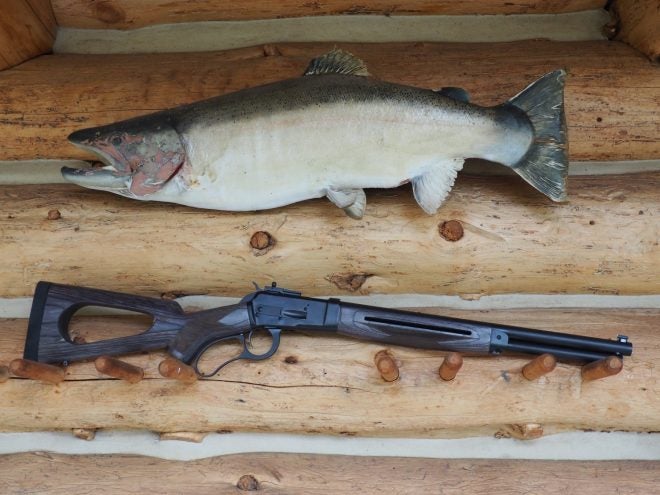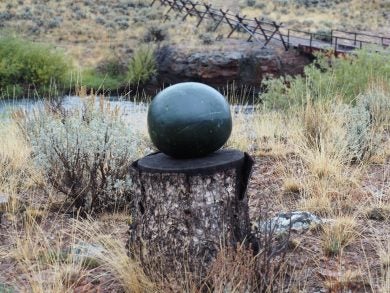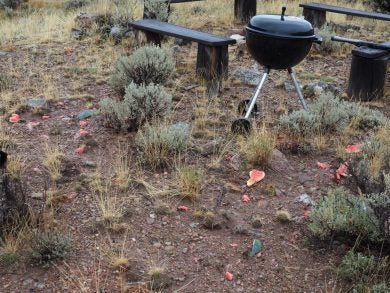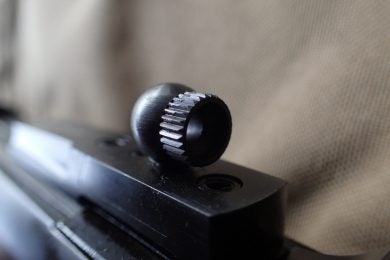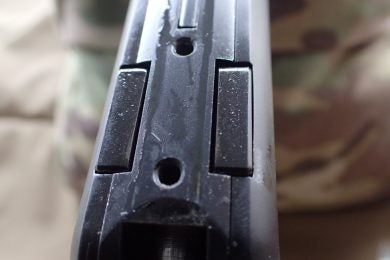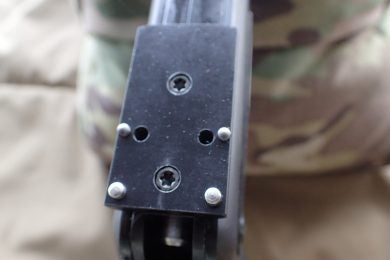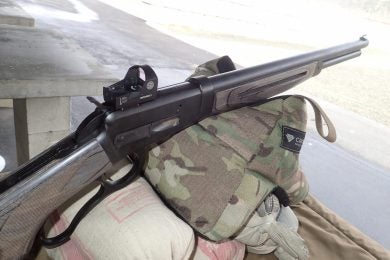Light Rifle, Heavy Hitter
I must admit that like many other Americans, I am preferential to heavy-grain, hard hitting cartridges. I also am enamored to lever-actions for hunting tough, thick skinned animals at ranges inside 200 yards and bear defense while hiking (and yes, James, I do reach for the bear spray first). I have previously shot .500 S&W magnum through revolvers, but I’ve always felt that the cartridge does not achieve its full potential in a practical length revolver barrel. Big Horn Armory of Cody, Wyoming has the solution to that issue with their Model 89 Spikedriver. Built from the ground up with a custom action based on the Winchester 1892 but upsized to between the 1892 and 1886, the Model 89 SpikeDriver is made from 100% CNC machined parts, using mostly 17-4 (SAE type 630) stainless steel. I’ve had an interest in trying out the Spikedriver Series of rifles from Big Horn Armory for some time. Thanks to our editor Phil for reaching out to the good people at Big Horn Armory, I got the opportunity to not only test out a Model 89 Carbine, but a new, rarely seen model of theirs: The Model 89 Spikedriver “Scout” Carbine with skeletonized stock and forend.
Specs, Per Big Horn Armory:
Barrel Length 18″ Caliber .500 S&W Rate of Twist 1 in 24″ Crown Recessed Buttstock & Forend American Black Walnut , Laminate Checkering 20 lpi Barreled Action 17-4 Stainless Steel Metal Finish Matte SS / Hunter Black SS / Color Case Hardened Stock Finish Synthetic Satin Recoil Pad 1″ Sling Swivel Mounts Integral Front, Stud Rear Sights Aperture Rear, Blade Front Magazine Capacity 7 Length of Pull 13 5/8″ Overall Length 37″ Weight (per author’s measurement) 7 lbs. 8oz. without Romeo 1 sight
Base MSRP: $2,499.00. Price as tested: Approximately $3000.00
First Impressions:
The Model 89 came in a nice, heavy-duty plastic hard case with custom foam cutout for the carbine. Upon opening the case, my eye was immediately drawn to the unique skeletonized grey laminate stock and fore-end. The carbine’s “Hunter Black” flat finish was smooth and very even. Picking up the carbine, I noticed immediately it’s relatively light 7lb 8oz weight for a rifle chambered in a big-bore cartridge. The carbine balances nicely, with the weight balancing right at the front of the action. The stock fits my larger hands quite well, and has a much larger grip circumference than my Marlin 94 to the rear of the action. The checkering on the stock is just aggressive enough. Working the lever, the bolt came back smoothly and the carbine was properly oiled out of the box. The cartridge elevator was also polished and jeweled, something I have not seen before with other lever actions. The skinner peep sight was mounted true and solid, and the white front sight bead was easily visible. The crown on the barrel was nicely done, giving very good muzzle protection in the field, and an even more extreme outline to the massive .50 caliber maw at the end of the barrel. Overall, the fit, feel and finish spoke well to the high grade craftsmanship from Big Horn Armory. This is a firearm that achieves being both a rugged tool and work of art at the same time.
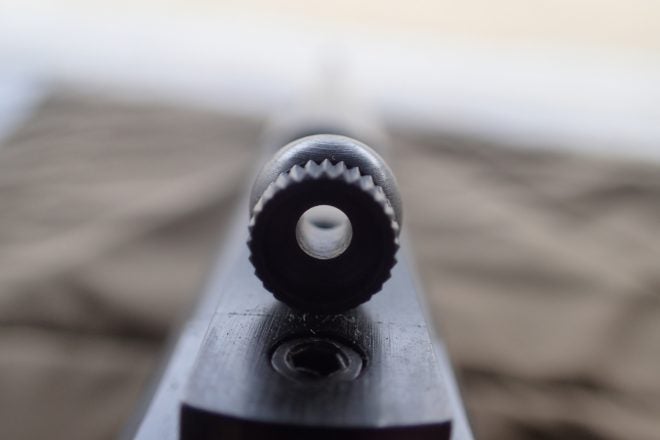
Rear peep sight
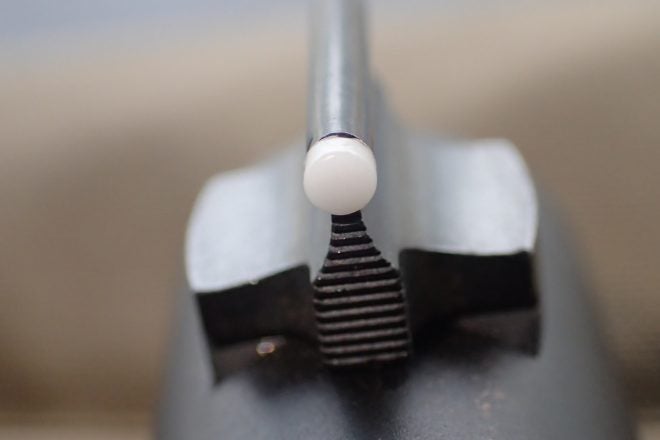
Front sight
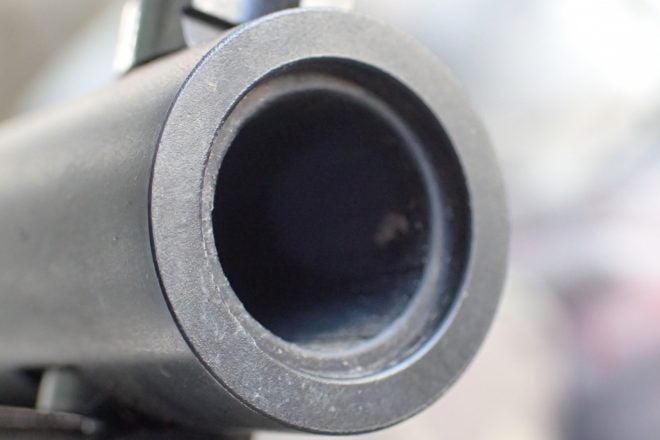
muzzle crown
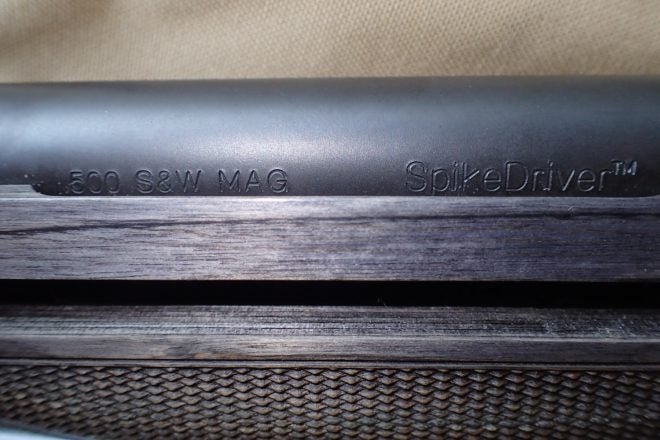
In the Field:
.500 S&W magnums and watermelon go together like peanut butter and jelly. It was only appropriate that I christen the Model 89 by vaporizing a watermelon. Loaded with Hornady’s 500gr flat point load, I took aim at 15 yards, and proceeded to instantly vaporize the melon, its pink mist melding into the freezing rain. Sporting an ear-to-ear grin, I tried out the next few offhand shots on various small rocks out to 150 yards. Each shot hit exactly what I was aiming at, demonstrating very good out of the box accuracy. I then slung the SpikeDriver, and headed out on a 5 mile loop to check my trail cameras. The SpikeDriver carbine carried well in a pack scabbard, at port arms, and slung throughout the hike. A note on slings and bipods: due to the front sling attachment point being recessed deeply in the fore-end cap, it is hard to attach some slings, as well as bipods like a standard Harris. Such a thing is not of great concern to myself, as I shoot lever-actions offhand or supported on a pack while hunting, but I there are adapters if one runs into these issues.
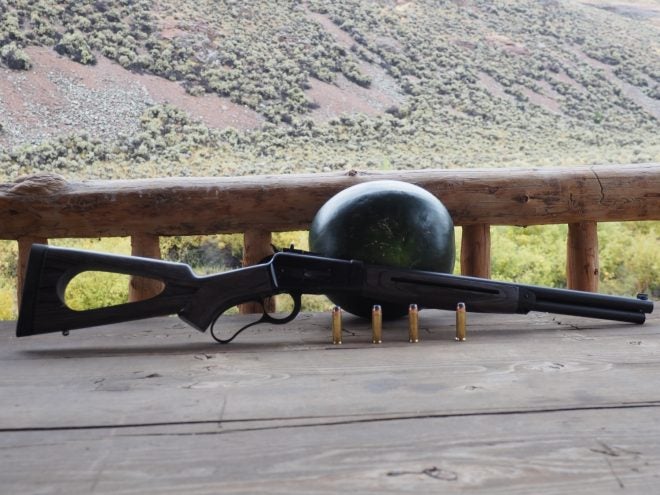
A .500 S&W chambered firearm with its natural target: A watermelon.
- Before
- After
- Im sure the local critters appreciated the frozen watermelon canapés that evening
The Hunter Black finish and laminate stock held up well to busting through high sagebrush and dealing with a mid-September snowstorm that swept through while I was hiking. After getting home from the hike, I inspected the rifle inside and out for any signs of rust from being out in the cold and wet for many hours, and there were none. There were not many areas that I had to clean dust, ice, and plant material out of, as the carbine is built well and fit together precisely.
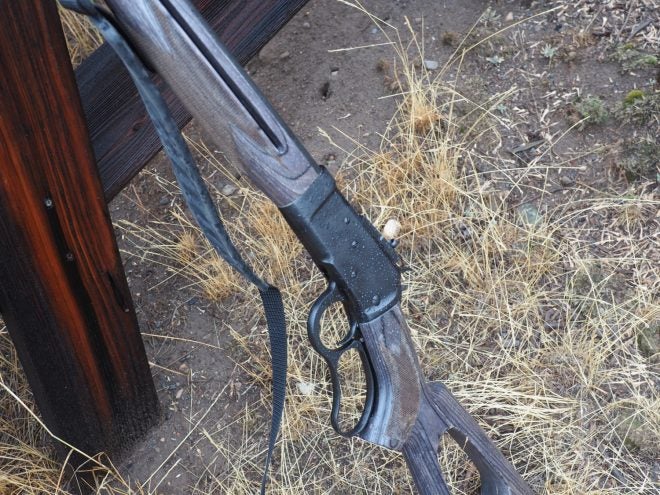
The weather was nasty…
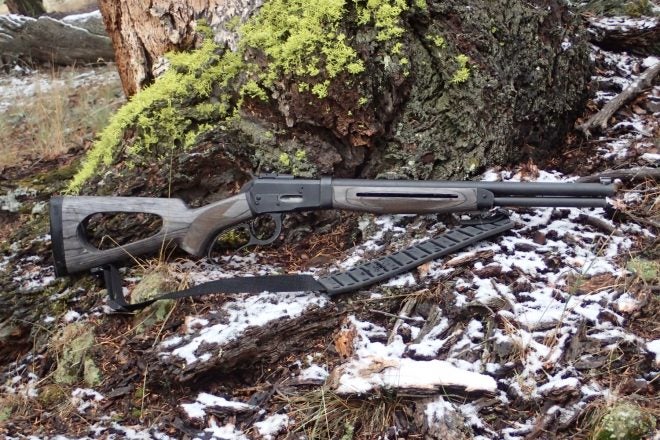
And got nastier! The SpikeDriver didn’t mind, though.
At the Range
After acquiring a wide selection of .500 S&W loads, I was ready to head to the range for some in-depth testing. It should be noted that Big Horn Armory recommends usage of Buffalo Bore loads 18A, B, and C for best performance in the Model 89. They also strongly advise against the use of any sharply pointed round (as with most tube magazine firearms), as these may detonate in the magazine tube under recoil.
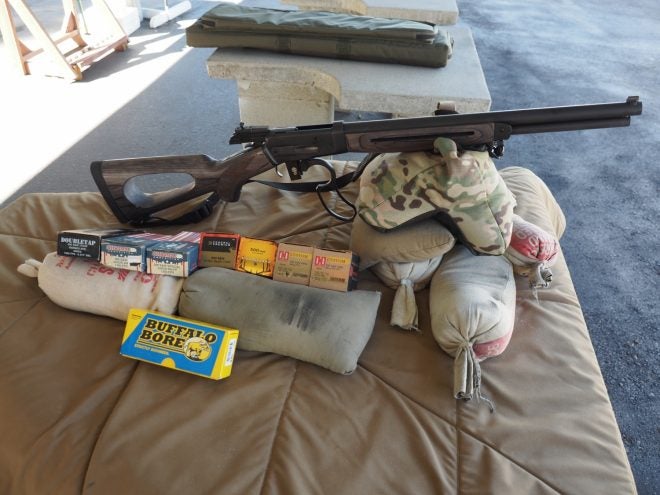
Getting set for initial sight-in. Ouch! My wallet!
During initial sight-in with the Skinner sights, I placed a 1/4″ dot on a sheet of paper at 50 yards and fired. The dot immediately disappeared. The sights were dead-on with the Hornady 500gr XTP. Despite this initial luck, I soon found that due to the great disparity in projectile weight, velocity, and profiles, with 275gr at the light end and 500 at the heavy end, one must be careful to have the sights set for a particular load. There was as much as a 9″ difference in impact height with different loads at 50 yards, or roughly 18MOA! After carefully noting this data by shooting all of the loads on a single large target, I was ready to move on to shooting groups. My best result with the iron sights at 50 yards was with Hornady 300gr Flextip Leverevolution. It was a tight 1.5 inch group with all 5 rounds touching.
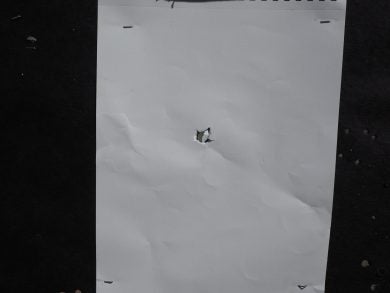
1st shot on paper, perfect hit. BHA took the time to factory zero this carbine.
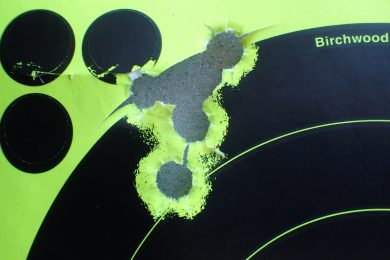
Best group with irons
After getting to know the capabilities of the iron sights at 50 and 100 yards, I mounted the generously provided Sig Sauer Romeo1 red dot sight. To do this, one detaches the Skinner sight from the top of the bolt carrier and mounts a red dot plate. This plate then accommodates the Romeo1 sight. I sighted in with the Romeo1 and managed to shoot a 1.25″ group with Federal’s 325gr Swift A-Frame load. It was then time to move out to 100 yards.
- Skinner sight
- Skinner with small peep threaded in
- Sight removed to prep for red dot mounting plate
- The red dot plate mounted to the bolt carrier
- Red dot mounted and ready
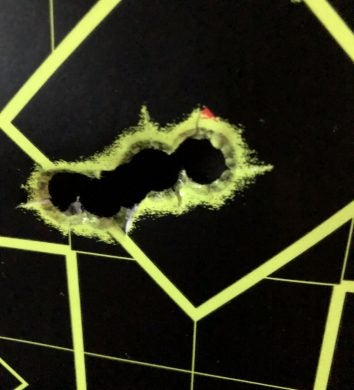
Best group with red dot
All groups were 5 shots and fired from a front and rear bag rest. Keeping in mind the point of impact changes between loads, I held at different aiming points, and still managed to get decent 2.5-3″ groups from:
- Buffalo Bore 400gr JFN
- Federal Fusion 200gr JHP
- Hornady 500gr XTP
- Doubletap 275gr XPB
The best groups were both around 2″ from:
- Hornady 300gr Flextip
- Federal Premium 325gr Swift A-Frame
None of the 3 loads from Ultramax that I tested functioned, fed, or grouped well at either range.
Flush with data from the 50 and 100 yard targets, I proceeded to try my dwindling ammunition supply on the 12″ 200 yard gong. Though I did have to hold on the upper edge, hits were easy to achieve.
Range Observations:
As far as function, the Model 89 is excellent when paired with the correct ammunition. The trigger broke crisply and cleanly at 3.25lbs, without a hint of creep. The trigger is much nicer than the average 1892 or 1886 trigger. The action itself cycled well with the Buffalo Bore, Federal, and Hornady loads. With the Doubletap Loads, I had to give the lever some extra oomph in the forward stroke to get the cartridge elevator angled up to the chamber. With the Ultramax loads, I was better off loading single rounds into the chamber by hand. They would not feed or function properly at all. I was surprised that the Hornady Flextip loads did not have an issue, as Big Horn Armory had advised me that feeding polymer tipped rounds can be an issue with the SpikeDriver.
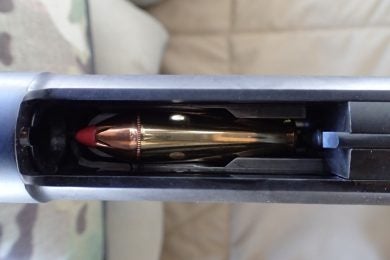
Flextip round feeding easily
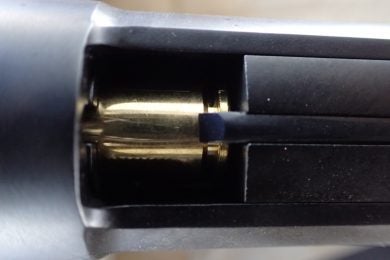
Extractor in place
Moving on to more varied and dynamic targets than just paper, I found that the SpikeDriver’s well balanced weight and fast handling is best suited to fast snapshots out to 150 yards from offhand or seated and supported positions. Cycling the action feels like a longer stroke than that of an 1894 or 1897 type action. The action also has a particular way it likes to be cycled. If the action is cycled smoothly and consistently, it is a dream. If one hesitates, however, it can lock up and require a lot more force.
I really appreciated the three different sighting options of the small or large skinner aperture or the red dot. My large fingers fit just fine into the lever loop, and I found no binding or pinching points while cycling the action. There was one minor issue I did have at times: the 1892-style loading gate would get hung up on the base of the last round into the magazine. To help deal with this issue, I would take an empty case and use the base to scoot the last cartridge into the magazine in order to close the gate. Recoil was a non-issue in prone, seated, or standing positions, due mostly to the very soft 1″ recoil pad.
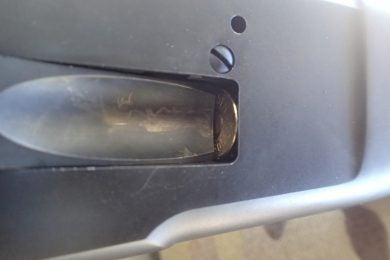
Sometimes the loading gate would hang up on the last cartridge. Model 92 designs are notorious for this
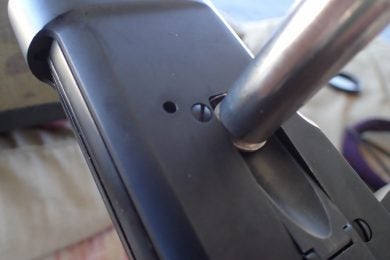
The easy solution (in the future I will take time to polish the face of the loading gate.
As far as energy delivered on target, Big Horn Armory has taken the time to test many cartridges in both their 18″ and 22″ barrels. There is a significant gain in velocity and energy over a 10″ revolver barrel. I was able to verify the following chart for a few loads with my own data. In many cases, one is getting 2-300fps more by using the carbine over a revolver. This represents a significant improvement in energy delivered on target.
Cartridge Specs, courtesy of Big Horn Armory:
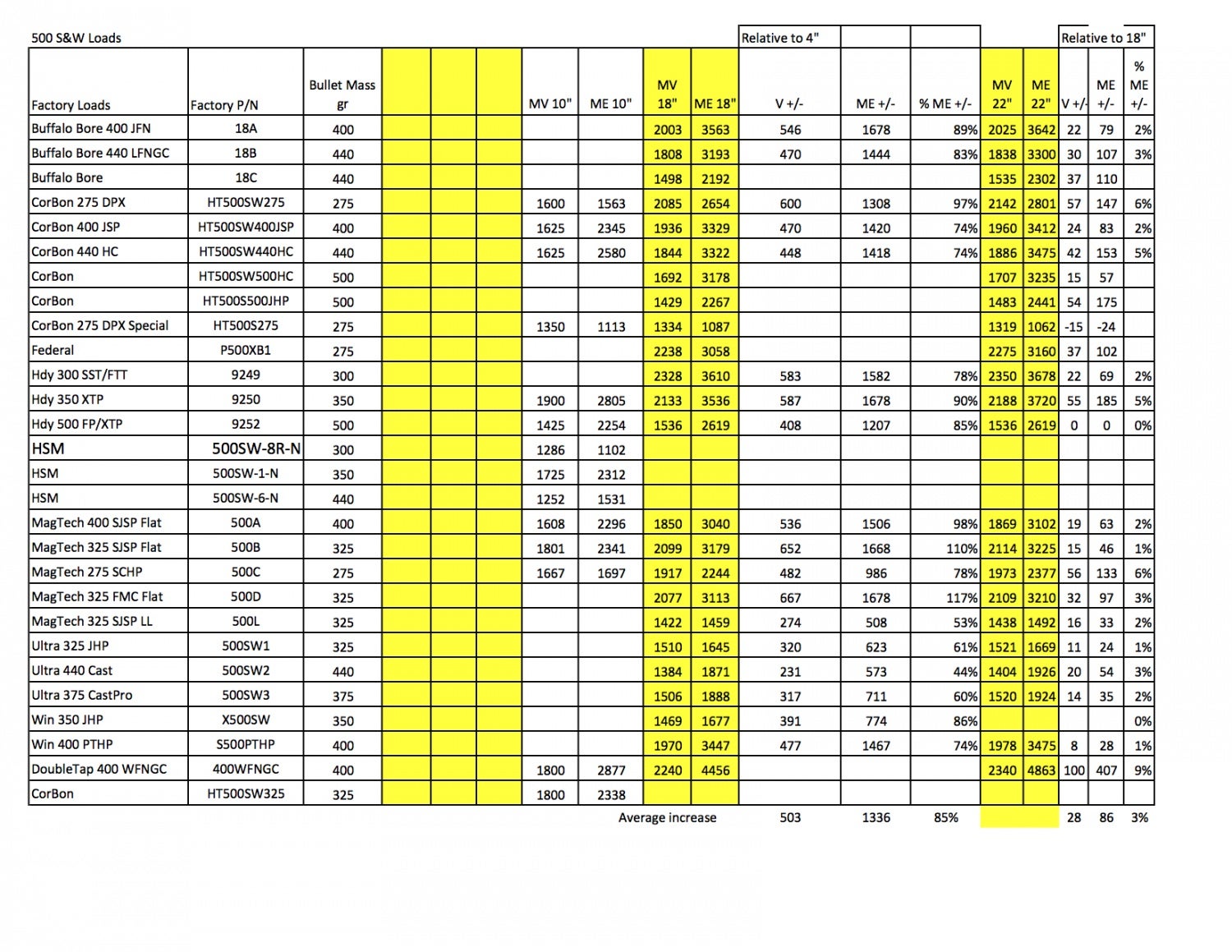
Overall Impressions
Overall, I found the SpikeDriver to be very well made, comfortable, and most importantly accurate enough to fit its intended use as a short-range hunting carbine or powerful “ranch gun”. Objectively, the Model 89 is made with quality materials, finishes, techniques, and craftsmanship. It also held up well to wet and freezing weather conditions, rough handling and getting dirty, without any blemishes or malfunctions. It is also an accurate firearm for its caliber. It does also offer improved capability from .500 S&W cartridges. Subjectively, it is fun to shoot, had low perceived recoil, carried well, and was easy to cycle.
Is it the most “practical” big bore carbine for short range work? No, that would be something like an AR with a .458 SOCOM upper. There’s still something to enjoy about lever actions and I personally have a lot of fun and success with them in the field. If one already has a .500 S&W revolver, this would be the perfect companion carbine, ranch, or rural truck gun, with a hard-hitting cartridge out to 200 yards. If one has been thinking about getting a well built lever gun, anything from Big Horn Armory would be an excellent choice even if a .500 S&W isn’t already in your inventory. The price tag may be high, but Bighorn Armory is up at the pinnacle of lever action craftsmanship. After thorough testing, I can wholeheartedly recommend the Model 89 SpikeDriver Scout for anyone who would like an extremely well-made, unique and hard-hitting carbine. Full disclosure: I liked it so much that I couldn’t bear to part with it and bought mine.
Pros:
- Makes the .500 S&W magnum cartridge hit even harder
- Made with CNC machined parts, excellent finishes, materials and craftsmanship
- Relatively lightweight for a big bore carbine
- Decent magazine capacity for getting the drop on a nest of wild boar
- Chambered in a cartridge that has a good selection of both factory cartridges and reloading components (for a big bore)
- Accurate
- Useable during some state’s short range/straight wall cartridge weapon seasons
Cons:
- Expense of the carbine and factory cartridges
- Recessed front sling mount is not compatible with standard bipod attachment and some sling attachment methods
- Less capable beyond 200 yards than a .45-70
- Loading gate can occasionally hang up on the last round into the magazine
- High cost of .500 S&W cartridges necessitates reloading (I will go this route) or waiting for loads to go on sale in order to accrue any quantity of ammunition at a reasonable price
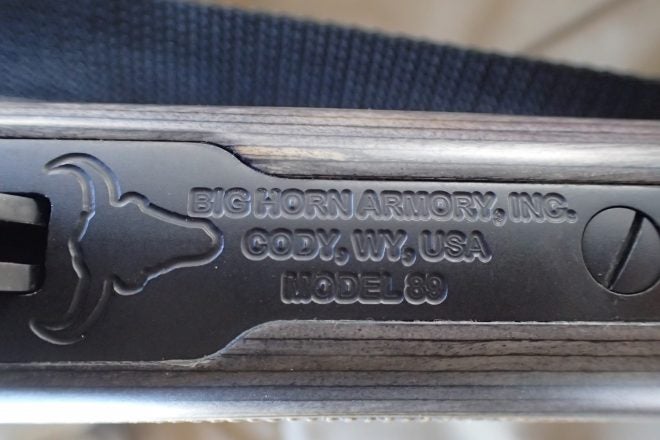
 Your Privacy Choices
Your Privacy Choices
